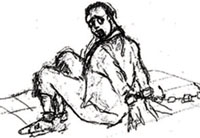9.1.5 Stigma, discrimination and abuse
In addition to the burden of their illness, people with mental illness and their families are highly stigmatised – that is, they suffer from the effects of stigma. Stigma refers to the way in which a characteristic, e.g. mental illness, marks the person out as different and leads to negative attitudes (prejudice) and behaviour (discrimination) from other people. This stigma increases the burden of illness further. People with mental illness may also experience abuse, e.g. being chained up inside a house, especially if the family doesn’t know any other way of coping with the disturbed behaviour (Figure 9.7).

- The stigma of mental illness means that people often hide away and don’t get the help they need.
- Discrimination against people with mental illness may mean that their family is treated unfairly, that the affected person doesn’t have as many work opportunities as he or she should do, or that he or she is excluded from community activities. Discrimination makes mental illness worse and it can delay or prevent recovery.
Later in this Module you will learn about ways to tackle stigma, discrimination and abuse against mentally ill people in the communities where you live and work. Next, we would like you to complete Activity 9.1.
Activity 9.1 What is it like to live with mental illness?
Is there somebody in your kebele who has severe mental illness? Try to find somebody who has received treatment in a psychiatric centre. If they are willing, ask them about their experience of being ill. What was it like? How did other people treat them? What help did they get? What would have helped them more?
Write your answers in your Study Diary and discuss them with your Tutor at the next Study Support Meeting.
9.1.4 Mental health and poverty (Millennium Development Goal 1)
